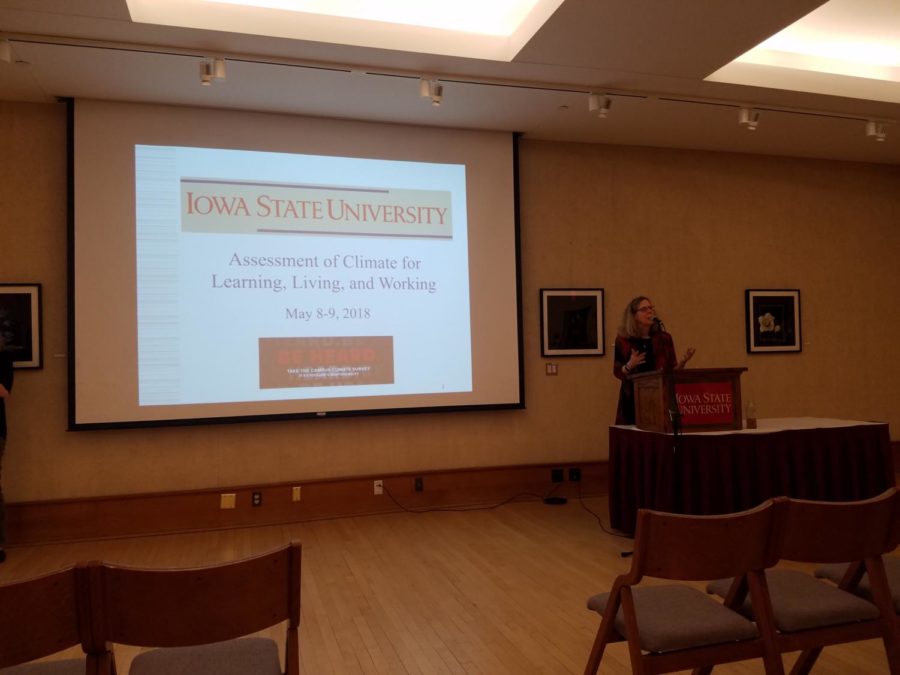Campus Climate Survey Part Three: Barriers for Marginalized Communities
President Wendy Wintersteen begins the discussion over the findings in the 2017 Campus Climate survey.
May 15, 2018
Barriers for Marginalized Communities
Some of the highest rates of uncomfortability on campus were reported by students with disabilities and students identifying as transgender, genderqueer or nonbinary. These groups face unique challenges on campus, which affect their perception of the climate in ways that don’t affect other groups. Here is the breakdown on those issues.
Respondents With Disabilities
With regard to campus facilities, 15 percent of Respondents with Disabilities experienced barriers in classrooms/labs, 14 percent in classroom buildings and 11 percent related to parking within the past year.
The most common themes reported by students related to mobility, coursework barriers, accommodation support and mental health issues.
Mobility
“There are not enough handicapped spaces close to my building, and they are not sufficiently monitored. I know that handicapped spaces are often used by non-handicapped drivers to just ‘run in.’”
“Walkways are at times too icy during the winter. Depending on the amount of snow, the attempt to brush the snow off the cement with the brushes only causes it to become buffed/polished ice.”
“My issue primarily manifests as a knee problem which periodically makes stairs difficult. Old, frequently malfunctioning elevators are a problem when my office and lab are on a high floor.”
Coursework Barriers
“The only time I feel Iowa State makes learning difficult with my disability (ADHD) is when we (3rd year vet students) have 4 hours straight of scheduled, non-optional lecture 4 days a week. It’s just too long for me to sit in one place and pay attention well.”
“Reading difficulty makes many of these things difficult. Tophat does not allow time or a way to make it work for those with testing accommodations. BB doesn’t have adjustable timing.”
Accomodation Support
“The campus has a long ways to go to be more inclusive and accessible for disabled students. Administrations commonly blow off students’ concerns and comments.”
“I have been told by a staff member that, because I have a disability, I will most likely work at McDonalds.”
“Receiving accommodations for learning disabilities is way too difficult. By the time you get through the process, you are worn out.”
Mental Health Issues
“The only issues I have had with my mental health is with the Student Services Office. After the 7-8 weeks of help, I was not really given helpful information of who to contact or where to find information to keep my therapy going.”
“I wish the student disability services had more to offer students who have depression/anxiety/ADHD. Being placed in a quiet room for tests and access to more notes do not help me.”
Respondents Identifying as Transgender, Genderqueer or Nonbinary
With regard to campus facilities, 28 percent of Transgender/Genderqueer/Nonbinary Respondents experienced barriers in restrooms, and 22 percent each experienced barriers in campus housing and signage within the past year.
Four themes were found in these responses. The first theme listed in the report specifically questions the validity of gender identity concerns. In the third theme, students discuss not experiencing issues simply because of the way they express their gender.
In two themes, transpectrum respondents expressed concerns regarding preferred name usage and being able to use the correct bathroom.
Preferred Name Usage
“It is impossible to change names and genders in the Iowa State system to my preferred name because it is not my legal name. Cannot change my email account from one that uses my dead name. Feel forced to use my dead name for all Iowa State correspondence.”
“It would be incredibly helpful to be able to change at least your preferred name on things like accessplus/ Blackboard/ ID Cards. Every semester I have to come out either to my professor and TA before class or in front of the whole class room, because my legal name has not been changed yet.”
Bathroom Concerns
“Also, a lot of signs, especially here where I live, say public restrooms are for a certain sex only. I don’t see very many gender neutral restrooms, which prevents me from going to the bathroom in public without feeling uncomfortable.”
“Restrooms are very limited in my building with only one male and one female restroom shared by multiple different groups. This can be uncomfortable for me. There are not enough gender-neutral restrooms on campus.”







